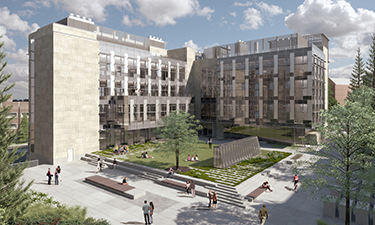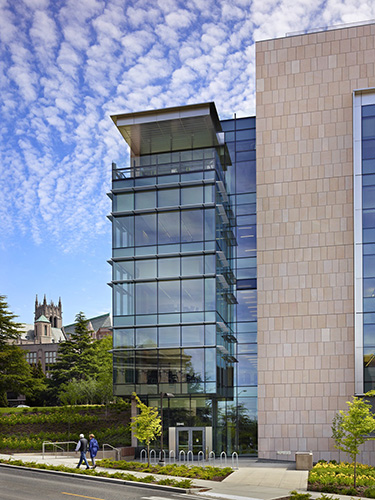|
Subscribe / Renew |
|
|
Contact Us |
|
| ► Subscribe to our Free Weekly Newsletter | |
| home | Welcome, sign in or click here to subscribe. | login |
Construction
| |
 |
November 19, 2015
No detail is too small for UW nanoengineering lab
ZGF Architects

Cooper
|
The 78,000-square-foot Nanoengineering & Sciences Building is the second phase of a 168,000-square-foot complex at the center of the University of Washington campus.
The first phase was the 90,000-square-foot Molecular Engineering & Sciences Building, completed in 2012. The two-phase project accommodates growth in the molecular engineering and nanoengineering fields, responds to the evolving interdisciplinary nature of teaching and research, and fits within a historic, high-density area of the campus.
The Nanoengineering & Sciences building will be specifically equipped for the performance of organic, inorganic and biomolecular synthesis, and will accommodate students and faculty in a variety of nanoengineering disciplines.
Sited in the science and engineering core of campus, the complex occupies a highly visible location on Grant Lane, and shares a courtyard completed as part of the Molecular Engineering & Sciences project. The buildings help to form and enhance outdoor public space and extend pedestrian pathways, aiding in wayfinding and connections to other parts of the campus and the surrounding community. Additionally, its proximity to other science and engineering buildings allows for cross-departmental pollination and joint research opportunities.
Fewer air changes
Research laboratory buildings present distinct challenges in achieving energy-efficiency. These challenges are largely due to unique programmatic and safety requirements, as well as heavy energy use for plug loads, ventilation, and associated heating and cooling needs.
The building will achieve LEED gold certification using integrated design strategies that focus on the environmental impacts of the laboratory operations. The building will incorporate the high-performance sustainability strategies that were utilized in the Molecular Engineering & Sciences Building, the first naturally ventilated laboratory on campus.
Air-change rates can be the single most influential factor in building energy use — using up to 50 percent of energy loads. The design team worked closely with UW to reexamine the number of air changes required to provide high air quality.
Consequently, air change rates were adjusted from approximately 10 to six per hour in main laboratory spaces. Chilled beams were selected for use in non-air-driven spaces such as labs containing ultra-sensitive electron microscopes and large pieces of research equipment in the building’s basement.
Another unique sustainable feature of the project is the use of phase-change materials (PCM) — a gel that becomes warm and liquid during the day and solidifies at night. Encapsulated in walls and ceiling panels, the gel reduces temperature as it changes material states.
The PCM is developed from vegetable oil and is “charged” at night when windows to office spaces are automatically opened to provide a flush of cool air. With the completion of phase one, the design team was able to set up temperature monitoring in the spaces, wall cavities and ceilings to quantify the effects of the PCM.
It was determined through two years of data collection that the PCM reduces the temperature around 1.5 to 2 degrees during peaks times on the hottest days of the year. This provided significant savings in the design of the mechanical systems for both phases as well as a beneficial cost savings to UW.
Light-filled labs
As was done on the phase one, the phase-two design also incorporates rain gardens. Stormwater runoff will be directed to the roof gardens, reducing runoff to additional drainage systems. Green roofs are planted with vegetation to attract native bees and support on-site water conservation efforts.
Along with the sustainable features, the building is designed with connectivity and transparency as key drivers. In phase two, the first floor of the building balances the research-intensive spaces of phase one by providing two highly adaptable classrooms and a large open informal learning area.
One large classroom is designed as an active learning space while the second is designed as a kit-based teaching lab classroom. The informal learning area provides additional breakout spaces for the researchers in the building and classrooms.
Access to daylight and open connections to lab spaces were high priorities in the design. Open, light-filled research labs offer views of the campus and University District, and puts “research on display.” The labs and offices are separated with glass walls and doors to maintain visual connections between the two spaces while also maximizing daylight to the interior spaces.
Designed for flexibility
The flexibility of space has been a key driver for both phases. During the design and planning of phase one and two, the team formed the building elements — such as columns and shafts — to allow for the greatest amount of flexibility and evolution.
The research labs were designed so that as the equipment, research and faculty change the spaces can support and morph as needed. The lab benches allow for equipment to be moved into and out of the lab spaces easily.
The overhead service carriers above the benches allow for researchers to “plug and play” in any location. At each end of the labs, there are rooms that can be arranged to house large equipment or specialty research spaces, depending on the tenant.
For phase two, with its mainly southern and northern exposures, a strategy was needed to address the added heat loads to the building due to the different orientation from phase one.
Where the radiant flooring is used in phase one for heating purposes, it is used for heating and cooling in phase two. In addition, chilled sails are utilized in the ceilings along the south wall of the office spaces.
The units are ceiling-mounted and flush to the ceiling plane. Radiating panels are supplied with chilled water for cooling.
Because this is a high-performance building, the time to commission the phase one building and do the fine-tuning of the systems took about one year.
The strong partnership between UW and the design team, as well as a commitment to sustainability, brings the Molecular Engineering & Sciences Building and the Nanoengineering & Sciences Building together to create one high-performance building that fosters a collaborative research environment for years to come.
Nicole Cooper is an architect with over 10 years of experience across a wide range of diverse project types.
Other Stories:
- How crews used BIM to cope with unwelcome surprises at Denny Hall
- Classroom of the future takes shape at WSU— and it's round
- New UW dorms revive a long-lost urban pathway
- UW, WSU find ways to do more with less
- WSU’s Paccar building houses 5 R&D labs
- WSU’s wine center aims to train next generation of winemakers
- UW: Top 10 capital projects
- WSU: Top 10 capital projects




